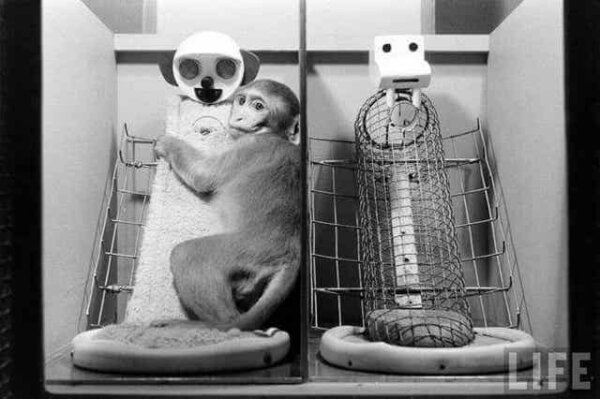The Pit of Despair - Monkey Business

The pit of despair was the climax of a unique experiment with monkeys. Harry Harlow conducted it in the 1950s. Try to place yourself back in that era to understand the true meaning of his study.
Thanks to the theses of John Watson, one of the pioneers of behaviorism, the world knew the idea that a baby whose parents were affectionate would end up having personality problems as an adult. Some truly believed that babies only needed food and hygiene. Parents shouldn’t pay them too much attention if they cried, as it would toughen them up.
One can say that an entire generation of Americans grew up under these precepts. Harry Harlow was no monument to affectivity, but he did have doubts about Watson’s theses. Such doubts consolidated in an experiment with monkeys, which led to others, including the pit of despair experiment.
“Do you know what makes the prison disappear? Every genuine, deep affection. Being a friend, a brother, a lover, is what frees us from prison. Without these affections, one is dead. But every time these affections are revived, life is reborn.”
-Vincent Van Gogh-

Before the pit of despair
The first experiment with monkeys
Firstly, Harry Harlow designed an experiment with monkeys to analyze some learning aspects. He wanted to protect the smaller monkeys from disease and figured that the best way to do so was to isolate them in cages. He kept everything clean and fed them at regular times.
After a while, he noticed the baby monkeys were healthier than those raised in a natural environment. However, they walked hunched over, sucked their fingers all the time, and spent many hours staring into infinity, not reacting vividly to any stimuli they received.
Then, Harlow wanted to pair them up so he mixed them with members of the opposite sex. However, those who grew up in isolation didn’t know what to do. Their ability to socialize was completely impaired and they basically had no reaction. In fact, they discouraged the company.
The second experiment involved the use of artificial mothers
Here, Harlow introduced plush fabrics to cover the cages and the little monkeys began to cling to them. They’d touch them frequently and despaired if someone wanted to take them away.
After perceiving this behavior, Harlow thought it would be a good idea to do a second experiment with monkeys. He referred to it as “the wire mother experiment” and became well-known after he made a presentation about it. Harry introduced surrogate mothers into the cages. He made a metal one with a bottle and covered the other one with plush but it offered no food at all.
As a result, the monkeys clung for more than 12 hours a day to the plush “mother”. They only came to the “wire mother” when they were thirsty or hungry. Sometimes, they even managed to eat their food without leaving the “plush mother”. This proved that contact, or rather physical stimulation, was essential for these babies.
The third experiment with monkeys
This third experiment was rather cruel and Harlow referred to it as “the gruesome mother”. He used dolls he made with the plush the monkeys were so fond of. However, some of these dolls had a mechanism that violently shook the baby that clung to their bodies when activated.
Other dolls had hidden metal spikes. These sometimes activated when the baby was clinging to the body of these surrogate mothers. Finally, other dolls had a device through which it sent out blasts of compressed air, which scared the babies.
As an end result, the little monkeys moved away from these dolls as soon as these rejection mechanisms went off. However, they returned to seek them out and clung to them when they noticed they “calmed down”.

The pit of despair and learned helplessness
The “pit of despair” was Harlow’s fourth experiment with monkeys. Basically, it consisted of putting the monkeys in cages where they had no contact with the outside world. Thus, they remained there for 30 days to a year. The result: all the monkeys broke down after a while.
They just sat there, doing nothing, in despair and hopelessness. Those who remained in isolation the longest had lost any ability to socialize by the time they came out. This led Harlow to his latest experiment, called the “iron maiden”. He wanted to see if this loss of sociability also manifested itself between mothers and sons.
He devised a device whereby males would sexually penetrate previously isolated females. It was a way to fertilize them in order to move on to the second phase. When these females had their babies, they also showed no ability to socialize with their offspring. In fact, they exercised violence and lacked motherly instincts.
Social groups that promote animal rights severely criticize Harlow’s experiments.
All cited sources were thoroughly reviewed by our team to ensure their quality, reliability, currency, and validity. The bibliography of this article was considered reliable and of academic or scientific accuracy.
Suomi, S. J., & Harlow, H. F. (1975). Experiencias tempranas y psícopatología inducida en monos Rhesus. Revista Latinoamericana de Psicología, 7(2), 205-229.
This text is provided for informational purposes only and does not replace consultation with a professional. If in doubt, consult your specialist.








